My Three R's for canine education – Rules, Routines, and Respect
By Michele Welton, Dog Trainer, Breed Selection Consultant, Author of 15 Dog Books
In my training program, you're going to teach your dog important vocabulary words.
BUT you must teach those words in specific ways. Otherwise your dog might learn the words, but remain disrespectful and disobedient.
You see, it's not the words themselves that teach a dog to be a good follower – it's the way you teach the words that conveys your character (or lack thereof) to the dog, who then responds to that character.
For example, some training methods teach the dog that you're an Abusive Bully. If the dog pees in the house or doesn't lie down immediately when told, he may be struck in the face, or beaten with a stick, or thrown to the ground, or hung in the air by his leash so he can't breathe. Because dogs are such incredible animals, they will continue to love an Abusive Bully owner, but they will fear him rather than respect him.
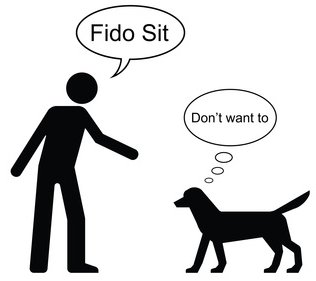
"Now what?"
Other training methods go too far in the other direction by teaching the dog that you're simply a Treat Dispenser. If the dog is hungry or "in the mood" to do what you say, he might do so in order to get the treat. Otherwise he will mostly do what he wants and you can't stop him.
In contrast, my training method teaches the dog that you are a Trustworthy Leader. As such, you're in charge and you make sure he minds you. But you're neither harsh nor unfair. When your dog recognizes you as a Trustworthy Leader, he feels safe and secure and is happy to do what you want. Yes, even when he's not hungry or "in the mood."
The Three R's for educating dogs
I'm sure you've heard of the Three R's for educating children. I certainly have, since my husband is a retired third grade teacher.
The three R's for educating children are Reading, 'Riting, and 'Rithmetic
In that spirit, my Three R's for educating dogs are Rules, Routines, and Respect.
First, let's look at Rules.
Rules are firm statements that tell your dog how things will be done in your family.
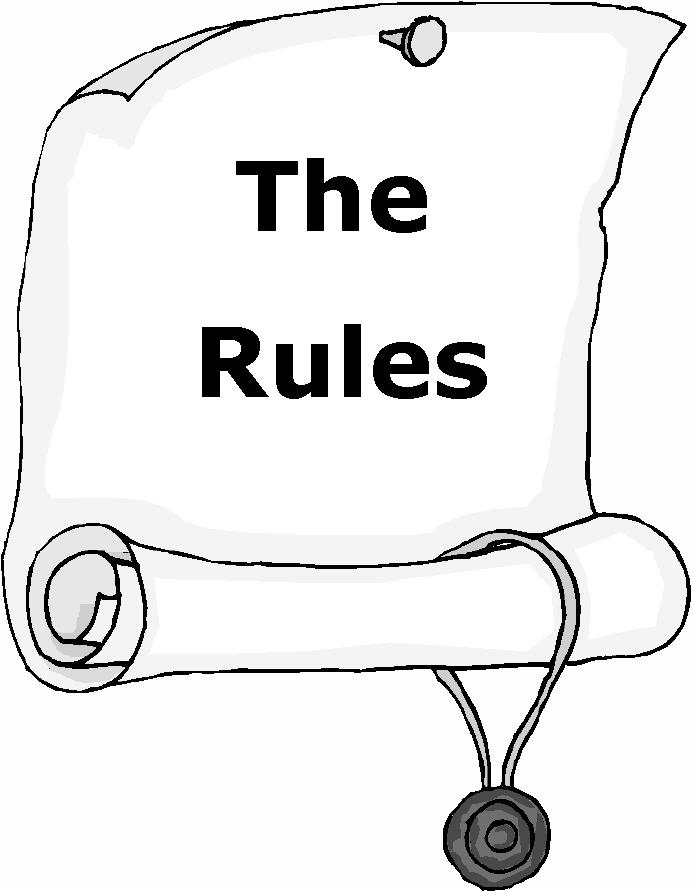 Rules tell your dog what he must and must not do in different settings inside the house, out in the yard, going for a walk, riding in the car, visiting the vet, having guests over for dinner, playing with the kids, and so on.
Rules tell your dog what he must and must not do in different settings inside the house, out in the yard, going for a walk, riding in the car, visiting the vet, having guests over for dinner, playing with the kids, and so on.
For example, here are some good rules:
Be calm indoors. No chasing the cat around the living room. Sit before I put your food bowl down. Sit before I attach your leash. Go to the bathroom here... not there. Don't pull on the leash during walks. Wait at doors and gates until I give you the OK to go through. No jumping on people. This is a chew toy... this is not a chew toy. You can bark at the doorbell, but once I answer the door, you have to be quiet.
To be effective, rules must be enforced. Rules that are not enforced are merely suggestions, not rules.
I'll explain how to enforce rules in Chapter 4.
Second, provide a structured life filled with Routines.
A routine is a regular and fixed way of doing something.
Dogs thrive on sameness, routines that are familiar, predictable, repeated. As much as possible, do the same things with your dog every day – the same things, in the same order, using the same words.
Also show your pup what you expect him to do as his part of the routine. Once he learns the routine for, say, meal time, if you do your part, he will do his part. Automatically. Day in and day out.
✓
The trick is to make sure the routines your dog is learning are good ones that lead to good behavior. If he learns bad routines, he will repeat them just as readily! The vast majority of behavior problems in dogs are caused by the owner (inadvertently) teaching the pup bad routines, or allowing the pup to create his own bad routines.
You want to create good routines that cover bedtime, wake-up time, meal time, play time, walk time, grooming time, potty breaks, and so on. Dogs feel most secure when their life is structured and predictable.
The vast majority of behavior problems in dogs are caused by (1) the owner not setting or enforcing rules; and (2) the owner allowing the dog to learn and practice bad routines instead of good ones.For example, here's a great mealtime routine
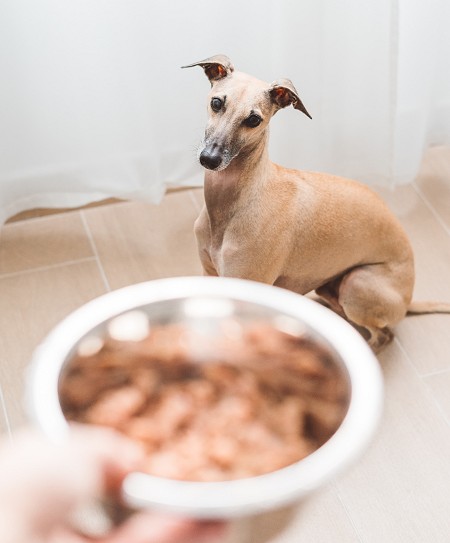
Good structured routines make dogs feel secure because they can predict what's going to happen next.
- Cue your pup when you're ready to prepare his meal. "Are you hungry? Want your food?" Exaggerate the key words.
- Have him come with you to the kitchen. Get his bowl from the same cupboard and set it on the same counter every time. He should be right there watching you. You want him to see that YOU are the source of his food.
- If he's acting excitable, don't put his food down, else he'll learn that excitable behavior makes the food appear! If he's racing around, barking, or jumping, he should be on leash so you can control him. Corrections for barking or jumping are in another article that I haven't uploaded yet. Hopefully I remember to come back here and add the links!
- When he is calm, the bowl is ready to go down. If he already knows how to sit (Chapter 31), have him sit first – another subtle and gentle leadership thing. Then.... "Okay!" and place the bowl on the floor, in the same spot every time. "Here's your food."
- If you have multiple dogs, each should have his own eating spot away from the others. Place the bowls down in the same order each time, saying the dog's name as his bowl goes down. "Buffy... here's your food. Mouse... food. Jenna... food."
- During mealtime, leaders protect followers. Don't let kids or other pets approach a dog who is eating. If one of your dogs is not well-behaved enough to obey this rule, he should be dragging his leash so you can get hold of him. If necessary, feed the dogs in separate crates or separate rooms. Stealing food is completely unacceptable.
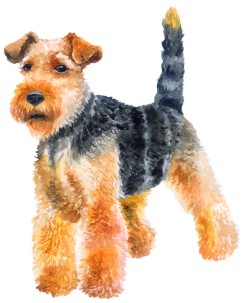 If a pup walks away from his bowl, pick it up; if there is still food left, make a mental or written note to monitor for any other symptoms that might suggest illness. After 10 minutes, all bowls, finished or not, should be picked up to avoid picky behavior or food guarding.
If a pup walks away from his bowl, pick it up; if there is still food left, make a mental or written note to monitor for any other symptoms that might suggest illness. After 10 minutes, all bowls, finished or not, should be picked up to avoid picky behavior or food guarding.
The final part of the routine is a potty break immediately after every meal. If you're still housebreaking, take the pup out on leash. If he's already 100% housebroken and eliminates reliably when you send him out himself, that's fine.
In either case, announce the potty break: "Do you need to go OUT? Time to go OUT."
The easiest way to raise and train your dog is to establish choreographed routines – same things, same order, same words – with yourself as the director, the one in charge. Create good routines, stick to them, and your pup's behavior will be predictable and good.
Your dog wants black and white rules and routines.
Everyone in your family should follow the same rules and routines with the dog.
For example, suppose you and your spouse allow different behaviors. You chase the dog off the sofa, but you invite him to jump on you. Your spouse lets the dog remain on the sofa but scolds him for jumping on people. Your daughter doesn't allow either of those behaviors, but she lets the dog haul her around on the leash.
There might even be a third family member, or a housekeeper, or even the folks at doggy daycare, who won't correct the pup for anything because they don't want him "to feel sad".
That's just nonsense.
Dogs feel most secure when their world is "always this" and "always that." Consistent, predictable, black and white.
So if mixed messages are happening in your pup's life, sort it out quickly. Either get everyone on board with the same training program, or else keep your dog away from people who are (even unintentionally) undermining it.
Later, when your dog is well-behaved, you can certainly be more selective/permissive about certain rules. I definitely relax or even eliminate some rules that I enforced consistently when my dogs were younger and still learning how to live politely in my household.
 During the formative months of training, there should be no maybes or sometimes. You may think you're being "flexible" or "nice" by going back and forth about what your dog is allowed to do. Your dog, on the other hand, will peg you as indecisive. Now he feels anxious, uncertain, and compelled to second-guess your decisions and test your rules to find out which ones are really rules, and which ones are up for grabs.
During the formative months of training, there should be no maybes or sometimes. You may think you're being "flexible" or "nice" by going back and forth about what your dog is allowed to do. Your dog, on the other hand, will peg you as indecisive. Now he feels anxious, uncertain, and compelled to second-guess your decisions and test your rules to find out which ones are really rules, and which ones are up for grabs.
Dogs do not do well with gray areas. If you allow one gray area, your dog is driven by instinct to second-guess another of your decisions, and another, to find out where the limits really are. This is stressful for your dog and no fun for anyone else either. So decide on the rules. Stick to them. Consistently. Everyone.
Finally, your relationship with your dog should be one of respect.
We've covered two of my Three R's for educating dogs: Rules and Routines.
Now we come to the third R, which is Respect.
Respect must go BOTH ways:
- A dog who respects you accepts your leadership and defers to it, looking trustingly to you for guidance and direction.
- An owner who respects her dog accepts the reality that he is a dog, a wonderful species called canine. He is not – and cannot be – a furry human, so we mustn't try to project our own human ways of thinking and feeling onto him. That's DISrespectful. Instead, respect him as a canine and interact with him in ways that canines understand.
To show your dog respect, give him what his species needs and deserves:
- a structured life filled with predictable patterns and routines, so the dog feels secure that he knows what will happen next.
- consistent rewards for desirable behaviors – plus corrections for undesirable behaviors – so the dog can make good decisions about which behaviors he should do, and which behaviors he shouldn't do.
- calm confident leadership, so the dog recognizes that you're in charge and looks trustingly to you for guidance and direction.
The next question is.... "DOES your dog respect you?"
In Chapter 2, I pointed out some rude behaviors you might see in dogs who do NOT view you as a leader.
Barking back at you... running away from you... refusing to let go of objects... pestering you... demanding petting... stealing food... growling... struggling during grooming... jumping on guests... Do any of those behaviors sound familiar?
How about the following behaviors?
- When visitors come to the door, does your dog bark a warning, but then look at you, expecting you to take over and handle the situation? That's trusting you as the leader. Or does he rush the door and pitch an ongoing fit, making his own decision about how to deal with this visitor?
- When you're ready to go for a walk and you open the door or gate, does your dog wait for your permission to go through? That's showing polite respect for you as the leader. Or does he lunge through the door or gate the moment it opens, oblivious to your presence at the other end of the leash?
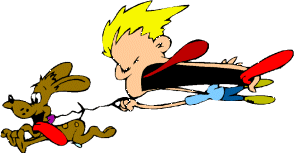 Does your dog walk nicely on a loose leash, glancing at you regularly to see which direction you want to go in? That's recognizing you as the leader. Or does he pull you around and make his own decisions to go left or right, fast or slow?
Does your dog walk nicely on a loose leash, glancing at you regularly to see which direction you want to go in? That's recognizing you as the leader. Or does he pull you around and make his own decisions to go left or right, fast or slow?- When a stranger or a strange dog approaches, does your dog look at you, expecting you to handle the situation? That's trusting you as the leader. Or does he make his own decision to bark and pull and lunge at other people or other dogs?
As your dog's guardian, your relationship with him should be one where he is taught to look trustingly at you for guidance, direction, and permission. That's the relationship every dog thrives on.
How to get your dog to trust you as the leader
With good rules and routines!
It's all bound together, you see – rules, routines, and respect.
 Yes, it's important to teach words such as "Come" and "Stay" and "Lie down." And we'll be doing that in this training program.
Yes, it's important to teach words such as "Come" and "Stay" and "Lie down." And we'll be doing that in this training program.
But what a dog needs most is to be lived with properly. Living with a dog properly includes some obedience training, yes. But teaching obedience commands like "Sit" or "Stay" only influences about 20% of the way your pup ends up behaving.
On the other hand, how you live with the dog around the house on a daily basis influences 80% of his behavior.
Think about that.
How you live with the dog means the rules and routines that happen in your household every day what you allow your dog to do, what you require him to do, and how you respond when he does "this" behavior or "that" behavior.
If your rules and routines are right....
If what you allow the dog to do is right....
If what you require the dog to do is right....
And if your responses to his behaviors are right....
Your dog won't have any behavior problems.
If he does have behavior problems, something about the way you're living with him isn't quite right.
So this book is not only about teaching words, but also about the rules and routines of living well with your dog.
Virtually ALL canine behaviors (good and bad) are created right there in your home by the way you live with your dog.
As you follow this training program, you'll be teaching lots of words, supported by consistent, black-and-white rules and predictable daily routines – all backed up by confident leadership.
When you teach these words, rules, and routines, you're truly educating your dog. Educated dogs are the most secure dogs in the world. They have learned so many words, routines, and good behaviors that they fully understand what is expected of them.
- They know WHAT to do.
- They know what NOT to do.
Dogs love the security of knowing what to do and what not to do.
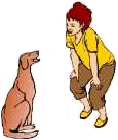 And whoever teaches them is the person they come to view as their trusted leader.
And whoever teaches them is the person they come to view as their trusted leader.
They look up to that person. They believe in that person. They trust that person to do anything with them, to handle them in any way necessary.
You want yourself to be that person. Which is why YOU should always be the one to train your dog.
You've heard of dog training schools that promise to take your dog to their establishment and train him for you, then send him home to you?
Now, if your dog has a serious aggression problem requiring expert evaluation and treatment, that might be your best (or only) option. Otherwise, I wouldn't consider it.
Dogs aren't robots who can be "programmed" by someone else to listen to YOU. Dogs listen to YOU and do what YOU say when they respect YOU – and they will only respect YOU when YOU are the teacher-leader who earns their respect.
No one else can do that for you. You have to do it yourself. In fact, each member of your family has to earn your dog's respect for themselves.
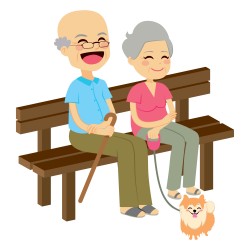 I hear this all the time from clients: "Jake listens to me, but not to my wife."
I hear this all the time from clients: "Jake listens to me, but not to my wife."
Or vice versa.
In a multi-adult household, it often happens that one person projects the right attitude and says and does all the right things, while another person does not.
Accordingly, the pup respects one person, but not the other.
If you're the only one working with the pup, the only one with the calm self-confident attitude, the only one following my training program consistently, your dog will listen to you but not necessarily to your spouse and kids.
As I said, dogs aren't robots who can be programmed to obey anyone who says the magic words. Because it's not the WORDS that cause a dog to listen to you and do what you want.
It's the proper leader-follower relationship that causes a dog to listen and do what you want.
It's important for ALL of the adults in the household to build the right leader-follower relationship with the pup.
How to teach words to your dog
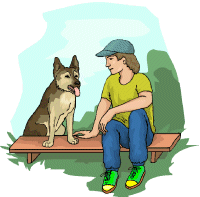
An educated dog is a thinking dog. He watches you. He pays close attention to you. He "reads" your facial expressions and body language. He listens carefully and pieces together individual words into complex actions.
"Where's your rope toy, Buffy? Go find it. Oops, that's your hedgehog toy. Drop it. Good girl. Now go find your rope toy. Is it upstairs? Go upstairs. Get your rope toy. Good girl, you got it! Bring it here. Good! Now give it to me. Give. Good girl, yay!"
Interested in a dog like that? Good for you! My dogs are like that – yours can be, too.
First, your dog has to learn the meaning of those words. That's where you come in.
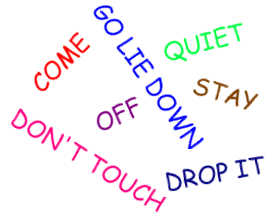
Some of the dog training commands every dog should know and obey.
Dogs aren't born with an understanding of what a word is. Dogs learn words just as babies do – by your saying "toy" over and over while holding up a toy. Until you connect a word with the correct object or action, words are only meaningless sounds to your dog.
 You actually have real-life experience with this! You've listened to people having a conversation in a foreign language, right? To them, it was an understandable language. But to you, it was all gobbledygook because the sounds were not connected to anything concrete so you had no idea what they might mean. In fact, the sounds all ran together; you couldn't even tell where one word ended and the next began. It was one long garbled sound.
You actually have real-life experience with this! You've listened to people having a conversation in a foreign language, right? To them, it was an understandable language. But to you, it was all gobbledygook because the sounds were not connected to anything concrete so you had no idea what they might mean. In fact, the sounds all ran together; you couldn't even tell where one word ended and the next began. It was one long garbled sound.
But let's say a person who spoke French repeated "pom" while holding up an apple. You'd get it, wouldn't it? You might not know how to spell it (it's actually spelled pomme ), but you'd understand that the SOUND pom referred to the red fruit.
In the same way, when you're teaching your dog what a particular sound means, you need to immediately connect that sound to its appropriate object or action. That's how you turn a meaningless sound into a meaningful word.
Don't talk too much
This advice may be hard for chatty people to follow.
But if you babble incessantly at your dog, he will struggle to pick out the few words he knows – the few words that really apply to him – from everything else you're saying.
Trying to wade through all that "noise" is stressful to a dog and eventually he will start tuning you out because he thinks understanding you is hopeless. Obviously, this is not what you want!
So, during your dog's formative learning period, when you're teaching him words, rules, and good behaviors, don't ramble on and on about how your day went. Instead, use very short sentences that emphasize one pertinent word or phrase.
- "Are you HUNGRY? Want your FOOD? Time for FOOD!"
- "Do you need to go OUT? OUTside? Time to go OUT!"
- "Want a BISCUIT? Here's your BISCUIT! Good BISCUIT, hmm?"
When your dog trusts you to use simple sounds that he understands, he will pay closer attention to you.
Later on, when he's further along in his training, go right ahead and pour out your heart to him when you need to. It's one of the reasons we love our dogs so much! But for now, keep your communication simple, short, and sweet.
Everybody should use the same words
All family members should agree on what a particular word means.
For example, don't do this:
- When Jake reared up and plunked his paws on Kathy's waist, she said, "Down!"
- When her husband Roger found Jake sleeping on a forbidden sofa, Roger said, "Down!"
- When their teenage son George found Jake rooting around in the attic, George pointed at the stairs and said, "Down!"
- And when the housekeeper wanted Jake to lie prone on the ground so she could clean his ears, she said, "Down!"
Poor puzzled Jake. The same word for four very different actions.
If Jake was my dog, I would be using "No" for (#1); "Off" for (#2); "Go stairs" for (#3) and "Down" for (#4).
As we work through our word list, go over each word with everyone in your family. Make sure you're all using the same word or phrase for the same behavior or object.
My best-selling books – now available FREE on my website
 Respect Training For Puppies: 30 seconds to a calm, polite, well-behaved puppy is for puppies 2 to 18 months old. Your puppy will learn the 21 skills that all family dogs need to know. Click here to read for free.
Respect Training For Puppies: 30 seconds to a calm, polite, well-behaved puppy is for puppies 2 to 18 months old. Your puppy will learn the 21 skills that all family dogs need to know. Click here to read for free. Teach Your Dog 100 English Words is a unique Vocabulary and Respect Training Program that will teach your adult dog to listen to you and do what you say. Click here to read for free.
Teach Your Dog 100 English Words is a unique Vocabulary and Respect Training Program that will teach your adult dog to listen to you and do what you say. Click here to read for free. 11 Things You Must Do Right To Keep Your Dog Healthy and Happy helps your dog live a longer, healthier life. Get my honest advice about all 11 Things before you bring home your new puppy, because some mistakes with early health care cannot be undone. Click here to read for free.
11 Things You Must Do Right To Keep Your Dog Healthy and Happy helps your dog live a longer, healthier life. Get my honest advice about all 11 Things before you bring home your new puppy, because some mistakes with early health care cannot be undone. Click here to read for free.
